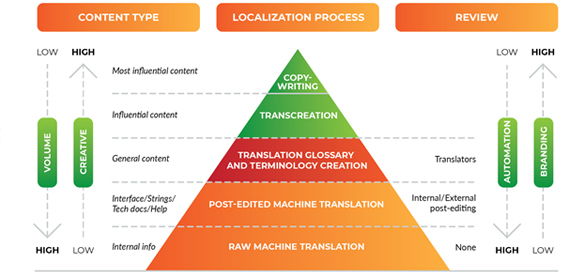The Importance of Localization in Gaming
The gaming industry is a huge, varied, and ever-evolving market that reaches hundreds of millions of fanatics around the world. Publishers and developers such as Take-Two, Electronic Arts and Activision Blizzard do their best every year to release a plethora of content that attempts to impress and engage their gigantic audiences. With that audience, however, comes some equally big obstacles alongside it, one of which includes appropriation for different demographics beyond the original. In this blog, I am going to outline the importance of localization in gaming and provide more information around this subject matter.
What is Localization and How is it Done?

Unless strongly interested in the works created and brought into your country from a different nation, you may not be familiar with localization. Simply put, localization is the process in which a company such as Janus modifies a product to be suitable for a different audience. In a broad sense, this could mean that Janus takes a game primarily aimed at an English-speaking country, for example America, and goes through the necessary steps to make this game comprehensible and easily accessible for another nation whose people are not primarily English speakers. It sounds like a straightforward task in theory, but I’m here to tell you all about the different trials a company like Janus goes through when localizing a product.
There are numerous ways localization can take effect, the most obvious of which is translation; through subtitles, change in user interface and through voice-overs or dubbing of characters. Going slightly further into the process, we often see much more in-depth areas, ones which rely on specifics brought up by the target audience. With this we may see a change in soundtrack, for example, dependent on culture, we as gamers come to expect different types of atmosphere for fighting environments, or simply those you roam around in. Some nations’ players may want a more calmed background music while they concentrate on fighting a boss, while others will be used to a fast-paced sound to set the tone of significance. It’s also important to keep in mind religion, and the audience’s beliefs, in a game such as Wolfenstein, littered with Nazi propaganda and references, the game is not suitable for German censorship standards and has been adapted as such.
It is also worth mentioning that localization goes far beyond just that of linguistics. Localization companies must consider the very bare bones of the product, from the somewhat overlooked systems of PAL and NTSC, to graphical gore, the product’s age rating, or something as simple as the different key binding’s for each nation.
This is where Janus comes in. Janus is one of the companies that strives to be the very best at localizing a wide array of products, with video games being of their biggest focuses.
All About Janus

Janus have over twenty years of translation experience in several different industries, with ten of those years being in video games. To help them through the years they’ve had the help of three hundred in-house staff members, and over two thousand linguists by their side. As of today, they continue to work with a wide-variety of clients, some of their biggest including Electronic Arts, Stardock and Disney. For these clients, they deliver that of technical, marketing, legal and learning based documentation, voice-over work, and helping with marketing aspects within the target country. For video games specifically, they are adamant in not only translation, but testing and advertising the product so that it works, gets noticed and is accessible for the desired audience upon release day. They do this through search engine and app-store optimization, on top of linguistic, function and bug testing, carried out to make sure this goal of release is possible,
Janus’ group of in-house development specialists take all of this and more into account when considering what’s important as they localize their next big game. Translation of the game’s core content such as dialogue, interface and lore is one step, but once that’s done, these specialists jump into the testing phase, which is done with the help of quality assurances tools such as JIRA. They stress test the game for function, linguistic integrity and general maintenance, which we will go into more detail below, thus confirming that come release day, the product is received as smoothly as possible by every audience it reaches.
Bug Testing and JIRA bug testing allows for developers to finely tune and comb their product for any issues that might not have appeared on the surface. They can review the game’s code, playback and its performance in a casual environment. This process is made possible with software such as JIRA, which is utilized by hundreds of thousands of clients around the world, some of which include NASA, Twitter, Skype, and Janus themselves.
The relationship between Janus and client doesn’t just end when the game is finished, as Janus are fully committed to helping with every aspect of the game’s production. This means ensuring the advertising makes sense in regard to the product’s tone, making the product accessible on the country specific marketplaces, and optimizing it on both desktop and mobile search engines, be that Google or the App Store.
How does Janus do it?
The two biggest areas of work for Janus are linguistic and function testing. Preparing the translation is one thing, but only when the game is on screen and being play-tested can the developers truly know if the translation works. Did that slang convey properly? Does the description of the item make sense? Was the tone of this dialogue as the author intended? These are the questions must be looked at throughout the process of localizing a project.
Linguistic testing: knowledge of context is key in localization. Context is everything, although we could very easily use Google translate to make out what someone is saying, we would find it very hard to identify their tone, or a way to respond to what they’ve said appropriately. Janus takes time and effort to make sure that context is the focus, if a game has bent an English word to fit an item or character in game, they must find a way to adapt that entity to meet the same context in a different language. This contextual adaptation impacts everything in-game, not just dialogue and character, but also smaller aspects that we often overlook, such as: menus, heads up display and item descriptions.
Function testing: although the root of everything Janus does is based on language, this root can be found in every single area of the work they do. Function testing looks less at the impacts of language, and more at the impact specific cultures have on the product, or way the product will run. These issues crop up as the game transitions into another nation, issues such as incompatible operating systems, or a need to look at the rating of the game once more in light of the different censorship laws each country possesses.
On top of product-based work, Janus prides themselves on client relations. They have both, their own API (application programming interface) connector, which integrates their tools for themselves and their clients to easily use. While also running the Janus Customer Portal, this allows clients quick and easy access to an online space full of work, updates, contact and analytics for projects Janus are currently carrying out.
Examples of Localization’s Importance
In conclusion, we find that although not always at the forefront of the minds of those in major demographics such as the USA or UK, localization plays a huge part throughout the world of media. This can be as simple as a Japanese-made anime being dubbed or subtitled into English and released on a streaming service, or can delve into the slightly more intricate.
For example, in 2007, the British Board of Film Classification and Entertainment Software Rating Board, completely banned Manhunt 2’s release in the United Kingdom. The game had to be almost entirely reworked in regard to gore, violence, language and severity of actions within missions. It was later resubmitted for certification and granted approval for release in the United Kingdom. This is why localization is so important, although in this context somewhat washing the game of its core colors and intention, it allows for other nations to enjoy the work under the laws of whichever country they live in. Within the target demographic, the game featured harsh violence in regard to executions and brutality. While in the UK, a nation where the first game had been at blame for the death of a teenager, enough felt that the violence was unnecessary, and therefore voted for its change.
Luckily, we have companies such as Janus to help the world experience different forms of media by adapting products in the most appropriate and adequate ways dependent on culture. Though you should also keep in mind that as long as the concept of region-locking is not applied to your country’s product, there are many legal methods to gaining access to the original work, as it was intended for its primary demographic.





